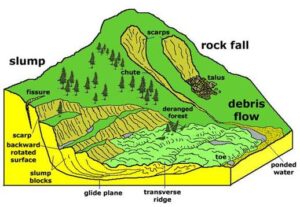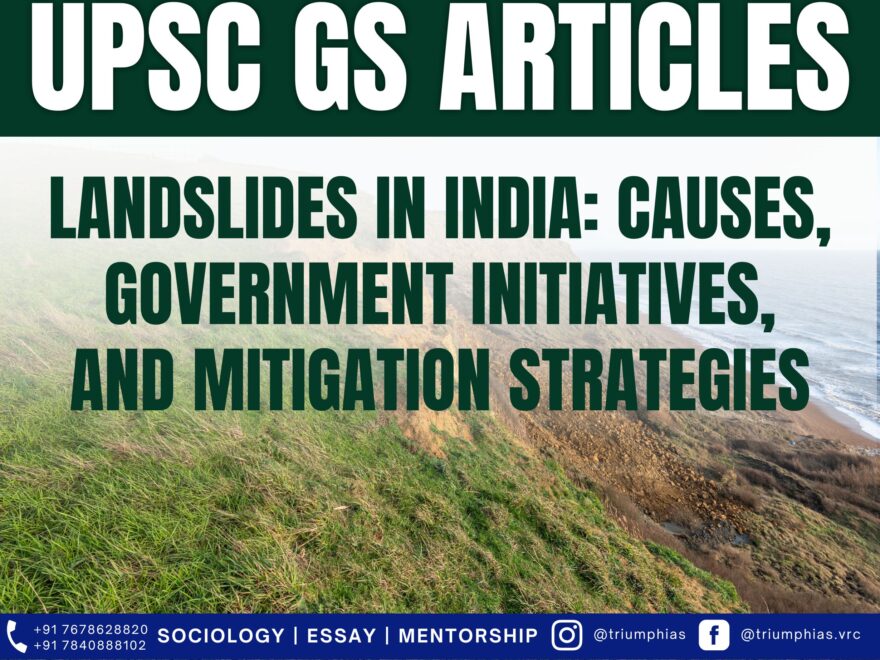Landslides: India’s preparations and steps
(Relevant for General Studies Paper Prelims/Mains)

Landslides
The recent fatalities and devastation caused by landslides in Himachal Pradesh have once again spotlighted the vulnerabilities and difficulties presented by the Himalayan ecosystem. Often referred to as the planet’s youngest and most rugged mountain range, the Himalayas constitute a distinctive and intricate environment that plays a pivotal role in shaping the area’s geology, climate, and biodiversity.
According to the Geological Survey of India, the financial losses attributed to landslides could potentially account for around 1% to 2% of the Gross National Product in many developing nations. Approximately 15% of the nation’s land area is exposed to the threats of landslides. Among the regions with heightened susceptibility are the Himalayas (both in the northwest and northeast of India) and the Western Ghats.
Landslide
A landslide is a geological occurrence characterized by the downward displacement of a mass of rock, soil, and debris along a slope. This movement can range from minor, localized shifts to substantial and devastating incidents.
Landslides can transpire on natural as well as human-made inclines, often prompted by a combination of factors such as intense rainfall, seismic activities, volcanic events, human interventions (like construction or mining), and fluctuations in groundwater levels.
Reasons behind Landslides in Himalayan region
- Tectonic or neo-tectonic activities, linked to a multitude of subsurface processes like rock deformation, rock exhumation, and rock reworking, alongside surface processes such as erosion, weathering, and rain/snow precipitation, contribute to the inherent fragility of the ecosystem.
- Climate-induced extreme events such as freeze-thaw cycles and heavy rain/snowfall result in avalanches, landslides, debris flows, glacial lake outburst floods, landslide lake outburst floods, and flash floods. These events compound the vulnerability of the mountain system. Moreover, the Himalayas face additional strain from human activities.
- Anthropogenic actions like road construction, tunnel excavation, mining, quarrying, deforestation, urban development, agriculture, excessive tourism, and hydroelectric projects can also trigger or exacerbate landslides in the Himalayas. These activities can disrupt the natural equilibrium of slopes by removing vegetation cover, altering drainage patterns, intensifying soil erosion, creating artificial cuts and fills, blasting rocks, and generating vibrations.
- Certain rocks in the Himalayas, notably limestone, are more susceptible to water-induced landslides due to their propensity to dissolve in mildly acidic rainwater or groundwater.
- The convergence of the Westerly Disturbance—a low-pressure system originating from the Mediterranean Sea that travels eastward across central Asia and northern India—and the South West Indian Summer Monsoon results in concentrated and excessive rainfall in regions of J&K, Himachal Pradesh, and Uttarakhand, leading to occurrences of landslides and flash floods.
Initiatives taken by the Government to mitigate the risk of landslides
- National Landslide Risk Management Strategy (2019): This comprehensive document encompasses all facets of reducing and managing the risk associated with landslide disasters. It includes aspects such as hazard mapping, monitoring, early warning systems, awareness campaigns, capacity enhancement, training, regulations, policies, as well as strategies for stabilizing and mitigating landslides.
- Landslide Risk Mitigation Scheme (LRMS): Currently in the preparation stage, this scheme aims to offer financial assistance for targeted landslide mitigation projects recommended by states prone to landslides. The scheme encompasses disaster prevention strategies, disaster mitigation, and research and development in critical landslide monitoring. This initiative will contribute to the creation of an early warning system and the enhancement of capacity-building endeavors.
- Flood Risk Mitigation Scheme (FRMS): Another scheme in the preparatory phase, FRMS focuses on various activities. These include initiating pilot projects to construct model multi-purpose flood shelters, developing flood early warning systems specific to river basins, and creating digital elevation maps to formulate inundation models. These measures are geared towards providing timely evacuation alerts to villagers during flood situations.
- National Guidelines on Landslides and Snow Avalanches: Formulated by the National Disaster Management Authority (NDMA), these guidelines provide comprehensive direction for mitigating the risk arising from landslides across all levels. Encompassing hazard assessment, vulnerability analysis, risk management, structural and non-structural measures, institutional frameworks, financial mechanisms, and community participation, these guidelines offer a holistic approach.
- Landslide Atlas of India: The Landslide Atlas of India serves as a comprehensive resource detailing landslide occurrences within India’s landslide-prone regions. This document also includes damage assessments of specific landslide locations. Prepared by the National Remote Sensing Centre (NRSC), a division of ISRO, this atlas provides crucial information and insights.
Measures that can be taken
- Building Resilience: To address these challenges, it is imperative to cultivate resilience against geological hazards stemming from natural processes, environmental degradation, and human actions. This entails establishing a network of sensors for real-time monitoring and data collection.
- Harnessing Technology for Vigilant Monitoring: Web-based sensors such as rain gauges, piezometers, inclinometers, extensometers, InSAR (Interferometric Synthetic Aperture Radar), and total stations have the potential to oversee vulnerable areas. The focus should be on monitoring densely populated and urbanized zones.
- Integrated Early Warning System (EWS): The creation of a comprehensive I utilizing AI and Machine Learning (ML) algorithms holds significant importance. Such a system could predict and alert communities about impending hazards, offering valuable time for precautionary measures.
- Establishment of Himalayan States Council: Forming a collaborative platform that brings together disaster management authorities from diverse Himalayan states is a strategic step. This centralized council would facilitate the exchange of knowledge, experiences, and resources, enhancing the assessment and management of the region’s various stressors.
- Simulation and Hazard Assessment: The council should concentrate on simulating and evaluating hazard scenarios resulting from natural occurrences, environmental deterioration, climate-induced events, and human interventions. This approach aids in comprehending potential risks and devising suitable mitigation strategies.
- Dissemination of Knowledge: While the Himalayan region exhibits diversity, the sharing of assessment findings across states is imperative. Collaborative endeavors and shared knowledge can lead to a more comprehensive understanding of challenges and potential remedies.
- Protection of Ecosystems: Safeguarding the region’s ecosystems takes precedence. By advocating sustainable practices and responsible utilization of resources, the council can ensure the preservation of the natural environment.
- Sustainable Socio-Economic Progress: Acknowledging the valuable natural resources within the region, including glaciers, springs, minerals, energy sources, and medicinal plants, presents opportunities for sustainable socio-economic advancement. However, it is vital to strike a balance between resource utilization and ecological conservation to ensure long-term viability.
- Environmental Considerations: Thoughtful urban planning that accommodates the unique characteristics of mountainous terrain is pivotal. Restricting extensive construction, implementing effective drainage systems, scientifically managing slope excavation, and utilizing retaining walls are critical facets of eco-conscious development.
- Retaining walls are relatively rigid structures employed for supporting soil laterally, thus enabling retention at varying levels on both sides.
- Building Codes and Evaluation: Meticulous mapping of towns and assessment of their load-bearing capacity constitute essential elements in formulating robust building codes. This approach guarantees safe and resilient construction, particularly in regions prone to natural hazards like landslides and earthquakes.
To master these intricacies and fare well in the Sociology Optional Syllabus, aspiring sociologists might benefit from guidance by the Best Sociology Optional Teacher and participation in the Best Sociology Optional Coaching. These avenues provide comprehensive assistance, ensuring a solid understanding of sociology’s diverse methodologies and techniques.
landslides, Himalayas, Geological Survey of India, disaster management, mitigation strategies, risk assessment, government initiatives, tectonic activities, climate-induced events, anthropogenic actions, Early Warning System, sustainable development, landslide-prone regions, natural hazards, National Landslide Risk Management Strategy, Landslide Atlas of India, Flood Risk Mitigation Scheme, landslides, Himalayas, Geological Survey of India, landslides, Himalayas, Geological Survey of India, landslides, Himalayas, Geological Survey of India, Best Sociology Optional Coaching, Sociology Optional Syllabus.
Why Vikash Ranjan’s Classes for Sociology?
Proper guidance and assistance are required to learn the skill of interlinking current happenings with the conventional topics. VIKASH RANJAN SIR at TRIUMPH IAS guides students according to the Recent Trends of UPSC, making him the Best Sociology Teacher for Sociology Optional UPSC.
At Triumph IAS, the Best Sociology Optional Coaching platform, we not only provide the best study material and applied classes for Sociology for IAS but also conduct regular assignments and class tests to assess candidates’ writing skills and understanding of the subject.
Choose The Best Sociology Optional Teacher for IAS Preparation?
At the beginning of the journey for Civil Services Examination preparation, many students face a pivotal decision – selecting their optional subject. Questions such as “which optional subject is the best?” and “which optional subject is the most scoring?” frequently come to mind. Choosing the right optional subject, like choosing the best sociology optional teacher, is a subjective yet vital step that requires a thoughtful decision based on facts. A misstep in this crucial decision can indeed prove disastrous.
Ever since the exam pattern was revamped in 2013, the UPSC has eliminated the need for a second optional subject. Now, candidates have to choose only one optional subject for the UPSC Mains, which has two papers of 250 marks each. One of the compelling choices for many has been the sociology optional. However, it’s strongly advised to decide on your optional subject for mains well ahead of time to get sufficient time to complete the syllabus. After all, most students score similarly in General Studies Papers; it’s the score in the optional subject & essay that contributes significantly to the final selection.
“A sound strategy does not rely solely on the popular
Opinion of toppers or famous YouTubers cum teachers.”
It requires understanding one’s ability, interest, and the relevance of the subject, not just for the exam but also for life in general. Hence, when selecting the best sociology teacher, one must consider the usefulness of sociology optional coaching in General Studies, Essay, and Personality Test.
The choice of the optional subject should be based on objective criteria, such as the nature, scope, and size of the syllabus, uniformity and stability in the question pattern, relevance of the syllabic content in daily life in society, and the availability of study material and guidance. For example, choosing the best sociology optional coaching can ensure access to top-quality study materials and experienced teachers. Always remember, the approach of the UPSC optional subject differs from your academic studies of subjects. Therefore, before settling for sociology optional, you need to analyze the syllabus, previous years’ pattern, subject requirements (be it ideal, visionary, numerical, conceptual theoretical), and your comfort level with the subject.
This decision marks a critical point in your UPSC – CSE journey, potentially determining your success in a career in IAS/Civil Services. Therefore, it’s crucial to choose wisely, whether it’s the optional subject or the best sociology optional teacher. Always base your decision on accurate facts, and never let your emotional biases guide your choices. After all, the search for the best sociology optional coaching is about finding the perfect fit for your unique academic needs and aspirations.
To master these intricacies and fare well in the Sociology Optional Syllabus, aspiring sociologists might benefit from guidance by the Best Sociology Optional Teacher and participation in the Best Sociology Optional Coaching. These avenues provide comprehensive assistance, ensuring a solid understanding of sociology’s diverse methodologies and techniques. Sociology, Social theory, Best Sociology Optional Teacher, Best Sociology Optional Coaching, Sociology Optional Syllabus.
Best Sociology Optional Teacher, Sociology Syllabus, Sociology Optional, Sociology Optional Coaching, Best Sociology Optional Coaching, Best Sociology Teacher, Sociology Course, Sociology Teacher, Sociology Foundation, Sociology Foundation Course, Sociology Optional UPSC, Sociology for IAS,
Follow us :
🔎 https://www.instagram.com/triumphias
🔎https://www.youtube.com/c/TriumphIAS
https://t.me/VikashRanjanSociology
Find More Blogs
|
Scope of the subject and comparison with other social sciences |
|||
|
|
|
|
Modernity and social changes in Europe |

